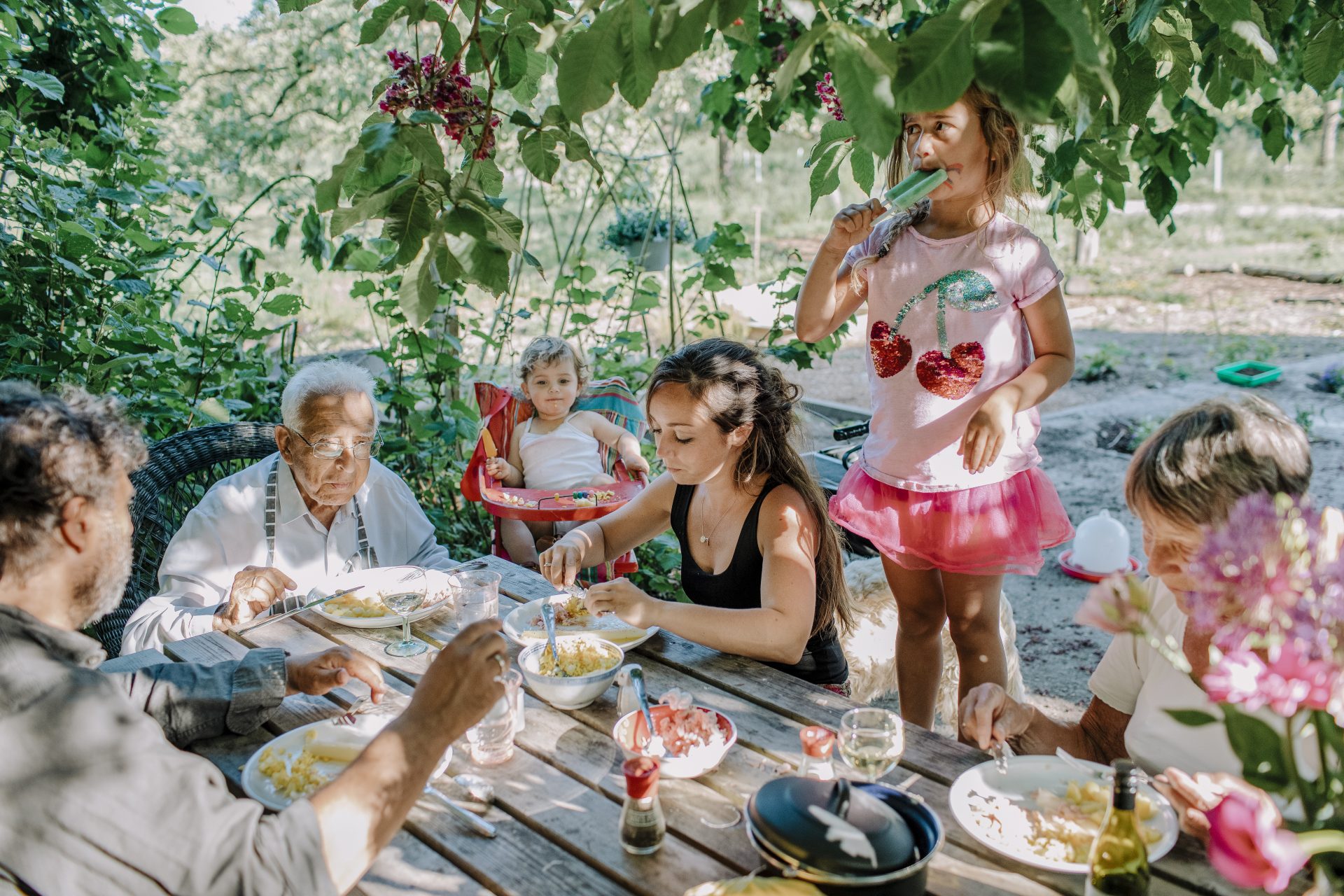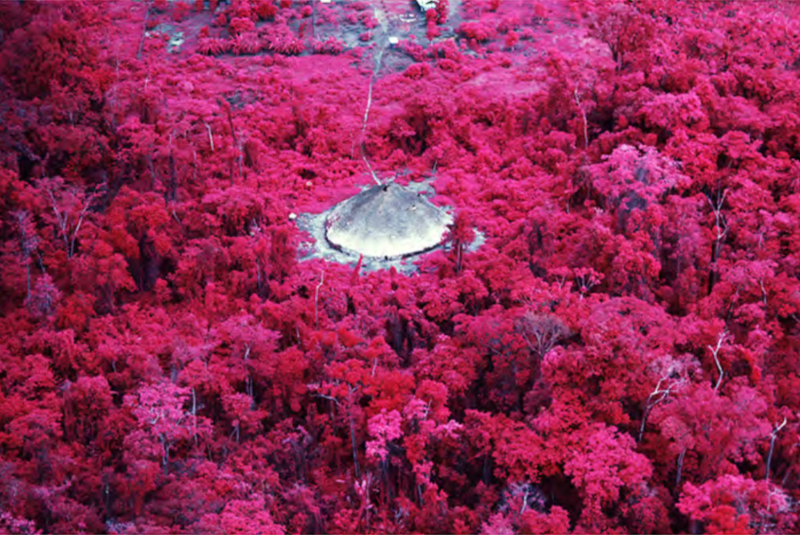
Claudia Andujar is one of the biggest names in Brazilian photography. She recently turned 90 years old, and for the last 50 years she has been dedicated to a cause, the Yanomami. Her work has been for this particular purpose, has reached a unique depth and, in so doing, surpassed the limits of photography in Brazil.
Claudia Andujar has been a pioneer who created new concepts in Brazilian photography, such as the artist-activist. She challenged a bloody military dictatorship. It is impossible to think about the Yanomami and not think about Andujar, or vice versa. For Thyago Nogueira, curator of Instituto Moreira Salles and one of the Brazil’s most important thinkers about art, there is a synthesis that makes up who Andujar is: woman, photographer, and someone who worked in the Amazon to give a photographic dimension to a culture that did not know photography. She has a unique visual interpretation of this culture. It is, according to Nogueira, an important combination of “approach, anthropological immersion, visual experimentation and political activism”.
With all this in mind, and being an admirer, I must say that I was looking forward to meeting Claudia Andujar. As I waited for the appointment, my hands were sweating, and with enhanced concentration, I noticed everything around me. She is one of those people who you always dream of meeting in person, and to meet her is to be part of an encounter of generations that use photography as a tool to understand the immensity and complexity of Brazil.
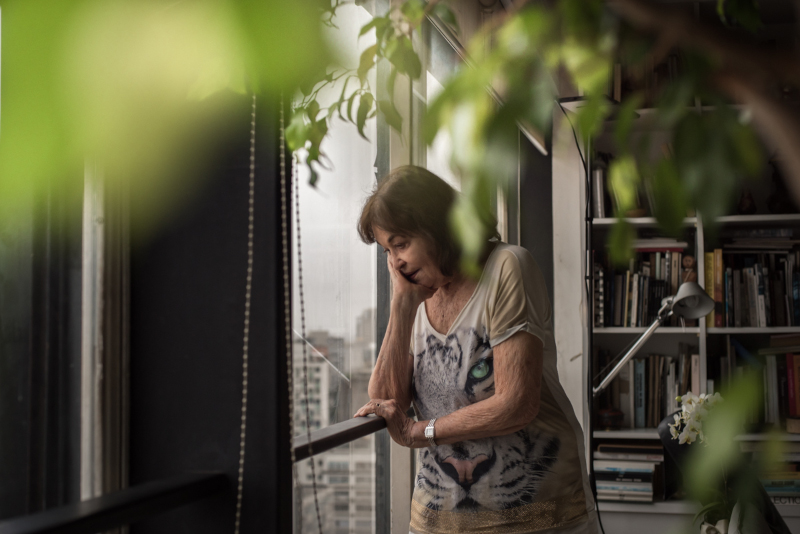
Andujar welcomed us to her apartment in São Paulo. In her living room with large windows, it was possible to experience the city’s typically cloudy winter afternoon. For almost two hours, our conversation took us from Transylvania to the Amazon, with serene pauses where Andujar seemed to explore her memory, searching for everything she experienced and felt during her odyssey.
Born in 1931 in Switzerland, just like her mother Germaine Guye, Claudine Hass, as she was then named, moved at a young age to Transylvania, the birthplace of her father Siegfried Haas. During World War II, Siegfried Haas was taken to Auschwitz, where he died. After the war, both mother and daughter returned to Switzerland via a clandestine and stressful train journey. “This was a time when nobody could know that I was a mixture between a Jew and a Protestant,” she confides. Her relationship with her mother was not the best. “It was complicated”.
That’s when an uncle invited her to move to New York. “Once again, learning to live in another way”, she says, with a lot of wisdom and a slight smile. She got a job as a salesperson at Macy’s during the day and studied at night. “So, I didn’t depend on anyone”, she says categorically. She was around 18 years old. In New York, she met a refugee from Spain and married him.
It was on American soil that she changed her name to Andujar and adopted the Spanish surname. The symbol of new life. However, it didn’t take long for fate to surprise her once again, and her husband had to leave the US, as he was drafted into the Korean War. “I was alone, but I turned around. I had friends, spoke English, worked and studied. Then I separated from him”.
In 1955, at the age of 24, Andujar went to Brazil to visit her mother, who already lived in the country. After a few weeks, the charm and connection with the new land were so great that she was no longer able to return to the United States. “I preferred it here over New York. I got on better with the Brazilian people”. This affinity was the basis for starting a journey that became her life’s purpose.
“In Brazil I started photographing. In the beginning, it was because I was wanting something to express myself. A language. When I started, I was living by myself. Photography became a friend of mine. I found a way to communicate with myself”. Andujar was an autodidact in photography. From a young age, she had shown an interest in the arts, even venturing into painting. She studied human sciences at Hunter College in New York, before she moved to Brazil, and says that for her these were her strongest references when entering this new format.
Although she did not yet speak Portuguese well, Andujar started traveling alone throughout Brazil. “Photography was a way to talk to someone”. And it was her friends, recognizing her good eye, who motivated her to continue with photography. “Then I discovered that I could use photography for a living, to have a job. And I was invited to photograph for Realidade magazine. I became a professional photographer”, she says with joy.
It was, though, not that simple. Before joining Realidade as a freelancer, mutual friends introduced Andujar to Darcy Ribeiro, a historian, sociologist, politician, and author. Ribeiro suggested Andujar’s immerse herself in Brazil’s indigenous community, with the aim of photographing something that no one had photographed before. Starting in 1958, Andujar spent two months with the Carajás tribe. She created a portfolio of her work, and while several Brazilian publications did not take it, her pictures were published abroad, with an eight-page report in Life magazine. This was enough to open doors permanently.
Andujar then began working as a freelance photographer and collaborated with international magazines including Life, Look, and Jubilee. Being published abroad increased her standing in photojournalism and opened doors in Brazil, where she started collaborating for the magazines Setenta, 4 Rodas and Realidade.
Realidade was a magazine that showed the less well explored and less well-known aspects of Brazil. It was a magazine that promoted debate about what Brazil was and how its people should be understood. Photography was an integral part of this reporting, with the work being much more than a way to beautify the text. Photography in Realidade was not decoration or illustration. It was an experience, and this was a unique moment for visual reporting. It was the perfect time and place for Andujar to shine.
Andujar worked as a freelance photographer for Realidade between 1966 and 1971. She was a contemporary of Maureen Bisilliat and, as there were then few female photographers working, editor José Hamilton Ribeiro was surprised that “two great photographers arrived, two great women”. The magazine provided an enormous learning experience for both, a way of getting to know the country in depth.
In October 1971, Realidade published a special edition on Amazônia with what became a legendary report on the Yanomami. This report is considered a milestone in Brazilian journalism and took almost a year to produce. To reach the Yanomami, Andujar had the support of missionary groups and anthropologist friends. The magazine’s editors feared that their special edition would be censored by the military dictatorship, so at first, the editors asked Andujar not to photograph the indigenous people. This was because the Yanomami inhabited land wanted for the ??construction of the Transamazônica highway, an infrastructure project the government planned to bring what they saw as economic progress to the region. In the end, Andujar made such powerful portraits of these communities that, despite the editors’ concern about censorship, the pictures were published, including on the magazine cover. The special edition had a major impact, selling 300,000 copies in the first week.
The magazine’s report had a national impact and disturbed the military government. It was probably a major factor in the magazine’s censorship and subsequent closure in March 1976. The report in the special edition on Amazônia was also a major turning point for Andujar. Her contact with the Yanomami had a profound impact and she decided to leave photojournalism to dedicate herself exclusively to producing a more personal body of work. Being a recipient of the prestigious Guggenheim fellowship on two occasions (1971 and 1977), Andujar had the proper support that allowed her to live with, know, and defend the Yanomami.
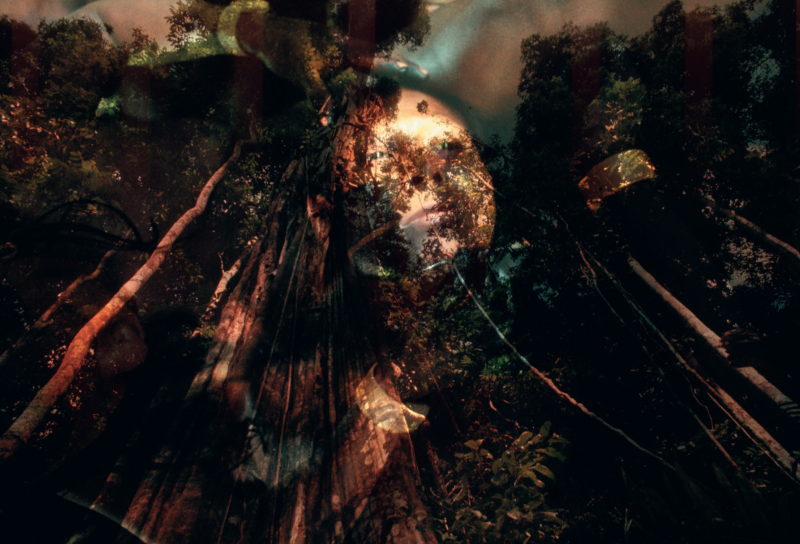
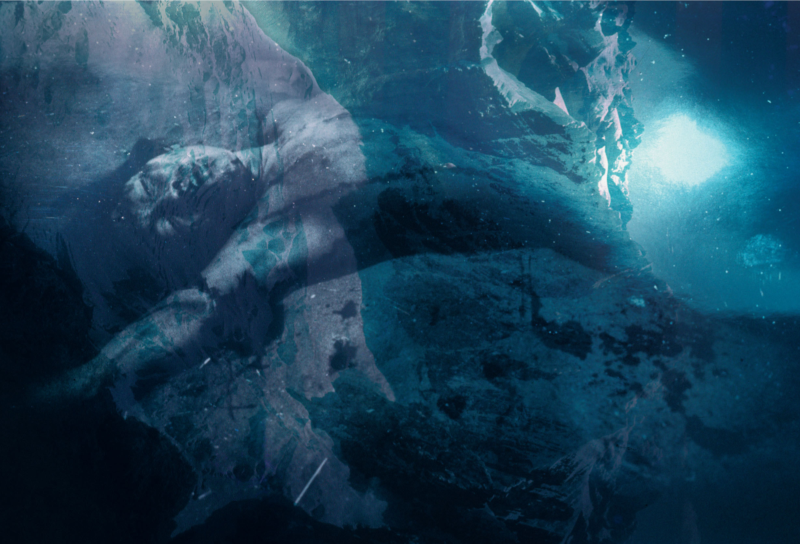
Andujar remembers this first contact with the Yanomami. “The first time I went there, they didn’t know who I was and why I wanted to talk to them.” She approached them in order to have a dialogue. She reveals that the first contact was not complicated. “They let me talk, get to know them. I felt comfortable. It was a very positive thing, I became their friend. In the beginning, I went there just for us to get to know each other, I didn’t arrive photographing. And that was very important.” She realized that for both parties to build trust, it was necessary to strike up a friendship before starting to point the camera. “I didn’t speak Yanomami and they spoke very little Portuguese. But we took the time to get to know each other. First, I showed them what a camera was because they had never seen it. Slowly, I started taking pictures, but it took a while.”
In order to represent the complexity and difference of Yanomami culture, Andujar experimented with her camera. She used Vaseline on lenses, filters, and other methods. Each technique, used throughout her career and in different projects with the Yanomami, manifests her constant search to understand a world was not hers. Andujar wanted to go beyond pre-established concepts and to go deeper into the imagery interpretation of a world that can only be understood from another perspective. The different techniques were a way of seeing what only the other can see, such as the trance induced by hallucinogenic plants of Yanomami shamans. “I wanted to go in, have greater intimacy, use photography for that. I wanted them to feel at ease, I didn’t want to insist on things. That’s why I was really working with them for years,” she says.
Shamanism, one of the main interests of Yanomami cosmology for Andujar, allows for a re-encounter with the teachings of nature. In his book Cannibal Metaphysics, Eduardo Viveiros de Castro, a Brazilian anthropologist, says it is a kind of cosmic diplomacy dedicated to translating ontologically heterogeneous views. He explains that the shaman acts as an intermediary between the different worlds and perspectives of all the rainforest beings. Andujar confirms this. “Knowing the meaning of shamanism was a learning experience, just like the Yanomami culture. This encouraged me to try to bring to photography what I felt as well”, she says. In projects like this, where one tries to break free from one’s shackles, access to the understanding of another culture is only acquired through the ordeal of the body, in the endless hours being with the Yanomami in the forest, and in the liberation of the mind, where Andujar reached the limits of own understanding to discover that of the Yanomami.
Andujar’s work impresses not only for its relevance, its strong social purpose, but also for her numerous and different forms of visual approach over decades representing the same subject. This includes overlapping beings with elements of nature in her series entitled “Yanomami Dreams”, where, according to the project description, “I managed to conceive an imagery interpretation of the rituals that gave me access to the genealogy of the people, bringing together aspects of culture, dissolving the borders between human beings, the gods and nature continuously integrating them.” It is also apparent in her powerful series of portraits named “Marcados”, which began with actions aimed at the health of the Yanomami, where numbered boards identified each indigenous person assisted, thus realizing, according to Andujar, “the look is the soul of each person”.
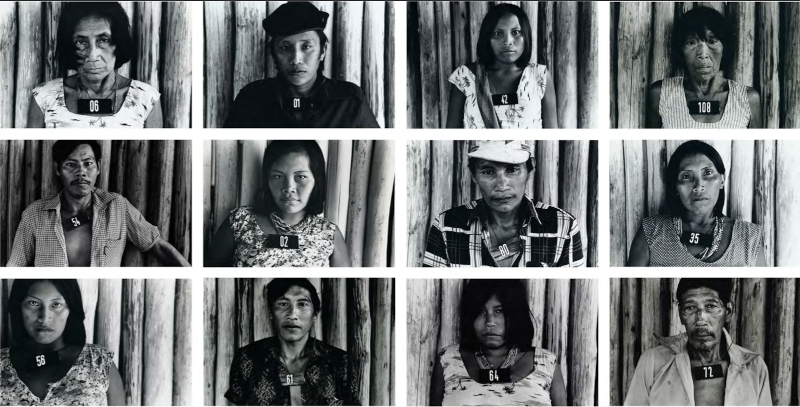
Andujar’s work intersects with avant-garde theories of understanding the other, including the Amerindian Perspective, by Eduardo Viveiros de Castro. Viveiros de Castro theorizes Amerindian thought as an unsuspecting partner of multinaturalism, which has affinities with contemporary philosophical programs, such as those that develop around a theory of possible worlds and “experimental metaphysics”. It involves indigenous thought provoking an attempt to place oneself as the other. Looking at her work ethnographically, Andujar brings us a true knowledge of ourselves, through the experience of another culture offering us a reflection on our own culture. This means accepting the opportunity to think with other minds, what Foucault called “penser autrement”. It means committing to the project of elaborating a photograph of conceptual imagination, sensitive to the creativity and reflexivity inherent in the life of every collective. Andujar’s work challenged boundaries including “language” and “world”, “people” and “things”, “us” and “them”. This is how Andujar’s work attempts to break the narcissistic mirror of traditional photography and decolonize thought.
Andujar says that she used a basic resource to capture the minds of the Yanomami: coloring paper and pens. At first – or if we pay attention only to this point – it may sound like an approach that wants to place the Yanomami as children. But this was not the case. It was just the beginning of a collaboration that resulted in one of the most incredible and important projects in understanding who the Yanomami really are. She was interested in knowing how they perceived the world. That was the idea. “They usually drew what they wanted. I didn’t say ‘do this’. I was interested in knowing how they reacted”. The lines they drew were touching, the true expression of a people in their first contact with someone who was interested in perceiving things from their perspective.
It was very clear to Andujar that, while her projects were works of photography, they were principally work of understanding the Yanomami people. “These two things are not separate,” she emphasizes. For the first time, the world had access to images of a life hitherto ignored. The Amazon region was not empty. The miners did not invade a land with no owners. The government did not open roads in the middle of a depopulated forest. There were people there – twenty thousand people Yanomami it was estimated. Yanomami, in Portuguese, means human being. There were human beings in the middle of the rainforest. And the white man, or napë in the Yanomami language, brought destruction and disease to these people.
It is important to say that in 1971, the Brazilian government launched a program with the objective of exploring what it called the “empty green continent” of the Amazon, opening it up to logging, cattle ranching, mining, and other industries. In 1973, thousands migrated to the Catrimani region – Yanomami territory – to work on the construction of the highway that would cross South America from east to west. This mass migration and unrestrained development led to disease, conflict, and social destruction for the Yanomami, which resulted in many deaths and environmental degradation. The situation worsened in the 1980s, when their lands were invaded by more than 40,000 miners. In total, more than 15% of the Yanomami population died from malaria and other infectious diseases.
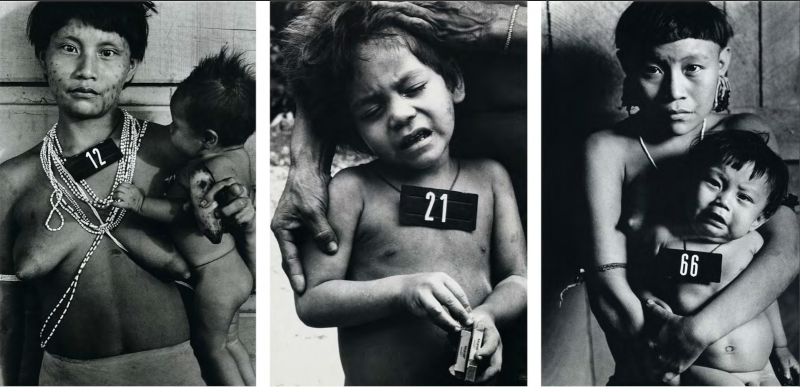
“Look”, says Andujar, “I think I was already an activist. It was part of my personality. Obviously, when I went there for the first time, I didn’t know who the Yanomami were. I dedicated myself a lot to understand them as human beings. I was convinced that I could, with my work, share my vision of these people with the world. That was what really mattered to me.” Andujar’s dedication to the Yanomami people took on a gigantic proportion of her life. It lasts until today.
Andujar became fully involved in the Yanomami struggle. She promoted exhibitions and went overseas to search for resources. Through her photography, Yanomami issues became better known. She was one of the powerful voices of the Comissão Pró-Yanomami (CCPY) and was at the forefront of the campaign for their territory demarcation and creation of the indigenous reserve. “That’s why I dedicated myself to their land, which is called demarcated. It was something very connected to my own wishes, to the meaning of life”. In 1989, the Brazilian government tried to divide Yanomami territory into 19 separate micro-reserves. The initiative was imposed with total disregard for the Yanomami way of life. The objective was to dispossess them of their land to encourage agricultural colonization and mining. Indigenous leaders and NGOs strongly opposed the government’s violent policy. To protest this proposal, the CCPY organized the exhibition “Genocide of the Yanomami: the death of Brazil”, in São Paulo. For this audiovisual installation, Andujar re-photographed 300 images from her archive using a gold filter and projected them onto various canvases. The installation presents a world progressively devastated by the violence of western colonization.
In 1992, following a campaign led by Andujar, Davi Kopenawa, Carlo Zacquini and Bruce Albert, among others, and supported globally by Survival International, the Brazilian government agreed to legally demarcate Yanomami territory as a continuous piece of land. Recognized on the eve of the United Nations Conference on Environment and Development (UNCED), this territory is, however, still threatened by the Brazilian government’s tolerance of deforestation and inaction dealing with 20,000 illegal miners operating in the territory. Working in the service of the Yanomami, Andujar’s extensive archive continues to give them a voice on the international stage, mobilizing against violations of their territorial and cultural rights.
Andujar is more than a pioneer in collaborative work with the Yanomami, attempting to get to know them more deeply and trying to think like them or understand how they think. She managed to go beyond the spectrum of photography. What could have been a passive record became a powerful weapon of effective action. And part of the income from her work goes to the Yanomami cause. “I have projects in which I put money at their disposal for them to be able to move on with their lives. I do that until today”. Currently, her work remains in vogue and has been exhibited in major cultural centers around the world, such as Paris and Milan in 2020, London and Barcelona in 2021, as well as the Institute of Contemporary Art in Miami and part of the “Inside the Amazon” exhibition at the Kunsthausbaselland in Basel, Switzerland.
I wonder if Andujar would have done what she did if her early life had been different, without the tragedy that World War II caused. I feel that the void that has been so present over the years was filled when she met the Yanomami people. They became her family.
More than four decades have passed since Andujar first set foot on Yanomami land. But the white man, in the words of Viveiros de Castro, continues in his “absurd inability to understand the rainforest”. The Yanomami continue to have problems because of illness. They continue to have problems because of invasions. They continue to have problems because of deforestation. On the day we spoke this year, six thousand indigenous people were camping in Brasilia, the federal capital, in the fight against the Marco Temporal (or “Time Limit Trick”) in draft bill 490, a measure that could change land demarcation rules. According to the bill, Brazil’s indigenous communities would only have rights to the lands that were in their possession on 5 October 1988, the date of the Federal Constitution, or that were in legal dispute at that time. In Brazil, indigenous territories are recognized by the Brazilian Federal Constitution, enacted in 1988. Chapter 231 guarantees that “indigenous peoples are recognized for their social organization, customs, languages, beliefs and traditions, and the original rights over the lands they traditionally occupy, and it is up to the Union to demarcate them, protect them and ensure respect for all their assets”. Now, the Brazilian Supreme Court is hearing cases related to this issue.
For the indigenous, it is the most important hearing of recent times, and involves Davi Kopenawa. Kopenawa, a friend of Andujar’s, argues that the white population “only study their own thinking and, therefore, only know what is already within themselves”. This argument is from Kopenawa’s book, The Falling Sky: Words of a Yanomami Shaman, written in collaboration with the French anthropologist Bruce Albert. But Andujar seems to have already overcome this barrier, as she is called “Mother” among the Yanomami people. Andujar notes, “the demarcation of their land was important, for them to be recognized as a people, for them to be able to live. I still have this perception. I do what I can. Now it’s not that easy for me to go there. There are some Yanomami who come here. And I still want to defend them. Nowadays, the government has no interest in them. We try to do things for them to be more respected”.
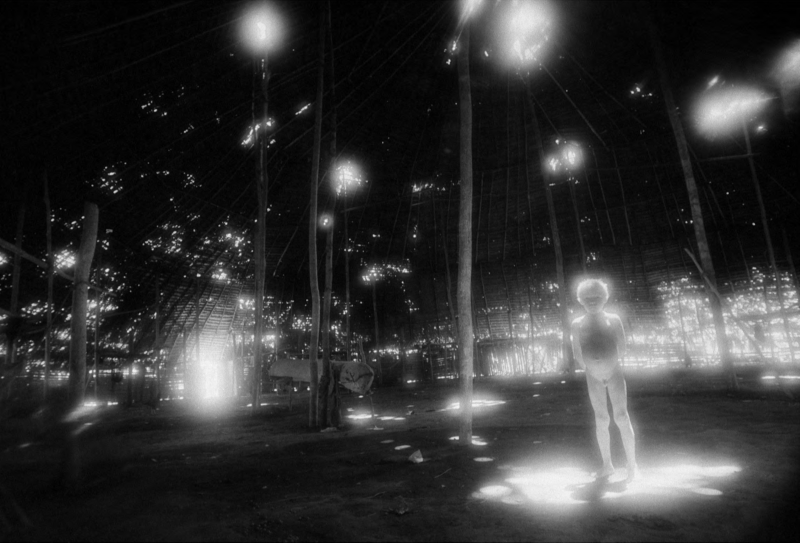
Claudia Andujar’s work is something that must be understood as a whole. Her status as artist-activist is respected amongst nearly all critics in Brazil. The search for understanding the other is the central thesis of Andujar’s work and as such it transcends photography. It took her 50 years of involvement in a cause to make, and what she did with the Yanomami had concrete results. Thyago Nogueira says that there have been some questions about who is in control in the Yanomami’s relationship with Andujar, but that these questions usually come from Europeans outside Brazil. “There is an insistence on analyzing Andujar as a white woman photographing indigenous people in Brazil. Framing her in a very colonial perspective, but her work developed in accordance with what she learned from the Yanomami. Brazilians tend to recognize that indigenous issues are traumatic, violent. And anyone who’s fighting alongside them deserves respect,” says Nogueira.
Claudia Andujar has not been to the Amazon for a few years. But she knows she will go back. “Probably,” she says. “I became known because of them. Now, I don’t know yet how this is going to proceed. But I am willing to continue fighting for them, for the Yanomami people”.
Author’s note: This article would not be possible without the essential collaboration of Galeria Vermelho. I also thank my great comrade Vitor Kruter for sharing his sensitive eye and my dear mentor Stefano De Luigi for guiding me sublimely through the everyday challenges of photography.
